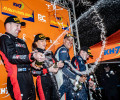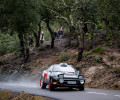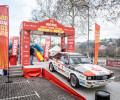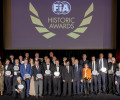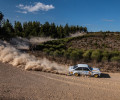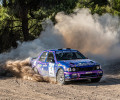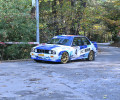A Sanremo Rally Storico full of surprises

The first dramatic turn of events occurred from the very first special stage, with punctures for the two Lancia Delta HF Integrale cars announced favourites to win. That of “Lucky” lost 1 minute 16 seconds straight away and ranked only 28th in the classification, while that of “Pedro” appeared in only 53rd place, having conceded nearly three and a half minutes from the opening kilometres!
Leader of the first and third special stage, Italian Da Zanche (Porsche 911 Carrera) also suffered a puncture, leaving Swiss Marc Valliccioni to take the lead, remarkably comfortable in his Renault 5 Turbo. The Swiss driver’s lead was, however, short-lived, as he came off the road in the Mini Ronde night-time special stage. As well as forcing him to retire from the race, his accident also caused the neutralisation of the stage and the allocation of a fixed time for the majority of the drivers, including Da Zanche, who thus found himself downgraded to fifth place when he could have hoped to close the opening race day in first position. The main drivers to gain from this turbulent end to the day were Italian Matteo Musti (Porsche 911 RS), promoted to leader, and “Lucky”, climbing to an astonishing second place after his setbacks in the first kilometres.
The start of the second day was scarcely less eventful, since Da Zanche (another puncture), Norway’s Jensen (suspension damage on his Porsche) and “Lucky” (coming off the road) were forced to retire one after the other. Matteo Musti held the lead until the finish, albeit narrowly, against an energised Erik Comas behind the wheel of his Lancia Stratos. The former Formula 1 driver, at a disadvantage on the first day due to engine problems, delighted the fans by reviving the mythic Stratos, which is now rare in historic competitions, and by driving it with great skill. Comas set the best time in the last four special stages of the rally and would have very much liked the rally to continue for another timed sector, as he finally lost out on victory by a mere 2 seconds and 9 tenths.
As neither Musti nor Comas are entered in the European Championship, it was Sweden’s Mats Myrsell (Porsche 911 RS), third in the overall final classification, and Italian “Pedro”, up to 4th place from 53rd, who were most successful in the context of the FIA Championship. Myrsell now has a solid lead in the provisional Championship classification in Category 2 (cars from 1970 to 1975), while “Pedro” is in the lead in Category 4 (cars from 1982 to 1990), ahead of French driver Patrick Canavese, 10th in Sanremo with his Lancia Rally 037. The Marenzana-Beltrame crew (Porsche 911 SC) is currently in front in Category 3 (cars from 1976 to 1981) and the duo Parisi-D’Angelo (Porsche 911 S) has the maximum possible points in Category 1 (pre-1969 car).
In parallel to this “Sanremo Rally Storico”, the “Coppa dei Fiori” was also being contested, counting towards the FIA Trophy for Historic Regularity Rallies. The course was almost identical to that of Sanremo (10 stages instead of 11), but the name of the game was not maximum speed for the 58 competing crews, but sticking as close as possible to a strict average speed of 50 km/h. In this exercise, Germans Sagel-Homann (Porsche 911 SC) were the most skilled, against the Italian-Monegasque duo Pretti-Giammarino (R5 Alpine), Finns Tairamo-Keippainen (Chrysler Avenger) and Finnish-Italian crew Hintikka-Paganelli (Porsche 911 Carrera).
The next round of the FIA European Historic Sporting Rally Championship will take place on 24 and 25 April in Klatovy, in the Czech Republic, with the Historic Vltava Rally.

 Facebook
Facebook Twitter
Twitter